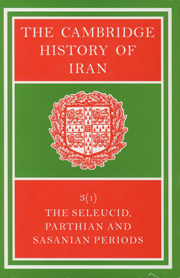Book contents
- Frontmatter
- Introduction
- PART 1 POLITICAL HISTORY
- PART 2 NUMISMATICS
- PART 3 IRANIAN HISTORICAL TRADITION
- 10(a) Iranian Common Beliefs and World-View
- (b) Iranian National History
- PART 4 IRAN AND HER NEIGHBOURS
- Bibliography
- Plate section
- Plate section
- Plate section
- Map 3. The western regions of the Sasanian empire">
- Map 11. The Silk Road from China to the Roman Orient
- References
(b) - Iranian National History
from PART 3 - IRANIAN HISTORICAL TRADITION
Published online by Cambridge University Press: 28 March 2008
- Frontmatter
- Introduction
- PART 1 POLITICAL HISTORY
- PART 2 NUMISMATICS
- PART 3 IRANIAN HISTORICAL TRADITION
- 10(a) Iranian Common Beliefs and World-View
- (b) Iranian National History
- PART 4 IRAN AND HER NEIGHBOURS
- Bibliography
- Plate section
- Plate section
- Plate section
- Map 3. The western regions of the Sasanian empire">
- Map 11. The Silk Road from China to the Roman Orient
- References
Summary
By national history is meant in this chapter the history of Iran as conceived by the Iranians themselves and embedded in Iranian historical tradition. Since the material for this history is party mythical and legendary, the chapter will inevitably touch also on Iranian myths and legends.
In exploring Iranian historiography in pre-Islamic times we encounter considerable difficulty: no historical books have survived from Seleucid, Parthian or Sasanian Iran. Our exploration must therefore be based on inferential evidence On the other hand, there is no doubt that comprehensive written histories did exist, at least in Sasanian times. The latest version of a fairly official historical book, the Khwadāy-nāmag (Book of Lords), which treated of Iranian history from its beginnings to the end of Khusrau II's reign (A.D. 628), seems to have been compiled under Yazdgird III (631–651), the last Sasanian monarch.
THE SOURCES
The Khwadāy-nāmag, together with other works pertaining to Persian history and legend, was translated early into Arabic, notably by Ibn al-Muqaffa' (d. 757). These works, with their Arabic renderings, served as a basis for new recensions of the national history in Persian. All direct Arabic translations or Persian redactions of the Khwadāy-nāmag have been lost, but works based on them by Islamic historians and Persian poets, chiefly from the 9th to the 11th century, survive. These are our main sources for a reconstruction of the later versions of the Iranian national history prior to Islam. The Avesta, the Achaemenian inscriptions and tablets, Middle Iranian inscriptions, ostraca, papyri, graffiti and coins all reflect elements of national history.
Keywords
- Type
- Chapter
- Information
- The Cambridge History of Iran , pp. 359 - 478Publisher: Cambridge University PressPrint publication year: 1983
References
- 22
- Cited by



